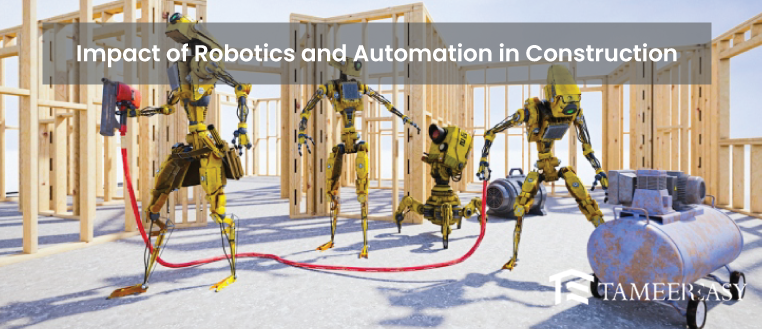The construction business has historically relied on human talent and knowledge because labour-intensive operations and complicated workflows frequently characterise it. However, the industry is going through a revolutionary change as a result of the rapid improvements in technology.
Robotics and automation are poised to revolutionise the construction industry and create a new productivity, security, and sustainability era. This article delves into the construction sector’s interesting realm of automation and robotics, examining their uses, advantages, and future possibilities.
Automation in Construction
Automation is the integration of mechanical and computer systems to simplify and carry out operations without the need for human interaction. It is used in construction in various areas, from design and planning to building maintenance. Real-time data analysis, precise engineering, and flawless coordination across various construction building processes phases are all made possible by automated technologies.
1). Building Information Modeling (BIM)
An excellent illustration of how automation is changing the construction industry is building information modelling (BIM). Construction project planning, design, and management are made possible by BIM. It offers a thorough 3D model of a building, enabling designers, engineers, and other interested parties to see the layout and identify potential conflicts or problems before construction starts. BIM accelerates project timeframes and reduces errors by streamlining communication, which lowers costs.
2). Construction Site Automation
Traditional methods are being revolutionised by automation on construction sites. Robotic systems can do repetitive and physically taxing tasks quickly and precisely. These devices, which boost productivity and lower the possibility of human error, range from autonomous concrete mixers and pavers to bricklaying robots that can lay thousands of bricks daily.
3). Drones and Robotics for Surveying and Monitoring
Drones with cutting-edge image technology are now indispensable instruments for surveying and keeping an eye on construction sites. They can quickly gather airborne data to make accurate topographic maps, track development, and spot potential dangers. This data-driven strategy boosts site safety, accelerates project management, and improves decision-making.
Robotics in Construction
Robotics, a subset of automation, uses machines with sophisticated sensors and preprogrammed intelligence to carry out activities autonomously or with little human assistance. Construction robots swiftly alter the sector dynamics, bringing improved accuracy, productivity, and safety.
1) . Robotic Construction Equipment
Robotic construction machinery is becoming more and more prominent in the market. Earthmoving jobs are being revolutionised by autonomous excavators, bulldozers, and cranes, which provide maximum precision and lower the danger of accidents. These robots can work around the clock and traverse difficult terrain, increasing project efficiency.
2). 3D Printing in Construction
3D printing is one of the most innovative uses of robotics in the building industry. Layer by layer, utilising different materials like concrete and other composite materials, large-scale 3D printers can now produce complete buildings. With this technology, building time, material waste, and labour expenses should all be greatly reduced.
Benefits of Robotics and Automation in Construction
Construction sector advancements towards a more productive and sustainable future are possible by incorporating robotics and automation technology.
1). Enhanced Productivity
Robots and automated systems are free from human limits like fatigue and the need for breaks, allowing them to work nonstop. The continuous workflow helps save time and resources through greater productivity and quicker project completion.
2). Precision Engineering
Robotic systems have unmatched accuracy and precision when performing jobs. The robotic workforce assures consistency in quality, minimising errors and rework, from cutting materials to laying bricks.
3). Improved Safety
Environments at construction sites are inherently dangerous. Construction organisations can reduce the chance of accidents and injuries to human workers by automating high-risk operations, resulting in safer working conditions.
4). Cost Savings
Even though the initial cost of robotics and automation can be high, there are significant long-term cost advantages. Efficient processes result in lower labour costs, better material utilisation, and quicker project turnaround times, increasing returns on investment.
5). Sustainable Practices
Concern for sustainability drives modern construction. Automation and robots enable better resource management, waste reduction, and energy efficiency. For instance, BIM optimises building designs for energy efficiency, and 3D printing reduces material waste.
Challenges and Considerations
As with any technological progress, using robotics and automation in construction has obstacles and considerations.
1). High Initial Costs
The initial expenditure for robotics and automated technologies may discourage smaller construction enterprises. However, costs are anticipated to decrease as demand grows and technology improves, making adoption more affordable for all industry participants.
2). Training and Development of Skills
To manage and maintain these intricate systems, there is an increasing need for competent technicians and operators as robotics and automation become more integrated. Providing enough training and skill development programmes will be essential to guarantee a skilled workforce.
3). Integration with Existing Workflows
Modifying current procedures and methods to integrate robotics and automation into conventional building operations could be necessary. To fully reap the rewards of automation, it will be crucial to ensure seamless human-robot collaboration.
4). Ethical and Social Implications
The expanding use of robotics and automation raises moral concerns about the future of human labour and job displacement. A successful transition will depend on finding a balance between human labour and automation, ensuring a reasonable transition, and offering opportunities for reskilling.
5). The Future Outlook
The construction sector will embark on a transformational path by integrating robotics and automation technology. We should expect even more disruptive changes as technology develops, including fully autonomous construction sites, self-repairing structures, and the growing use of AI-powered construction management systems.
Conclusion
The growth of robotics and automation has marked an important period in the history of the construction industry. Accepting this technological revolution will open up limitless possibilities for improved productivity, security, and sustainability. The construction sector will open the door to a smarter, greener, and more innovative future by overcoming obstacles and realising the full potential of these cutting-edge technologies.


